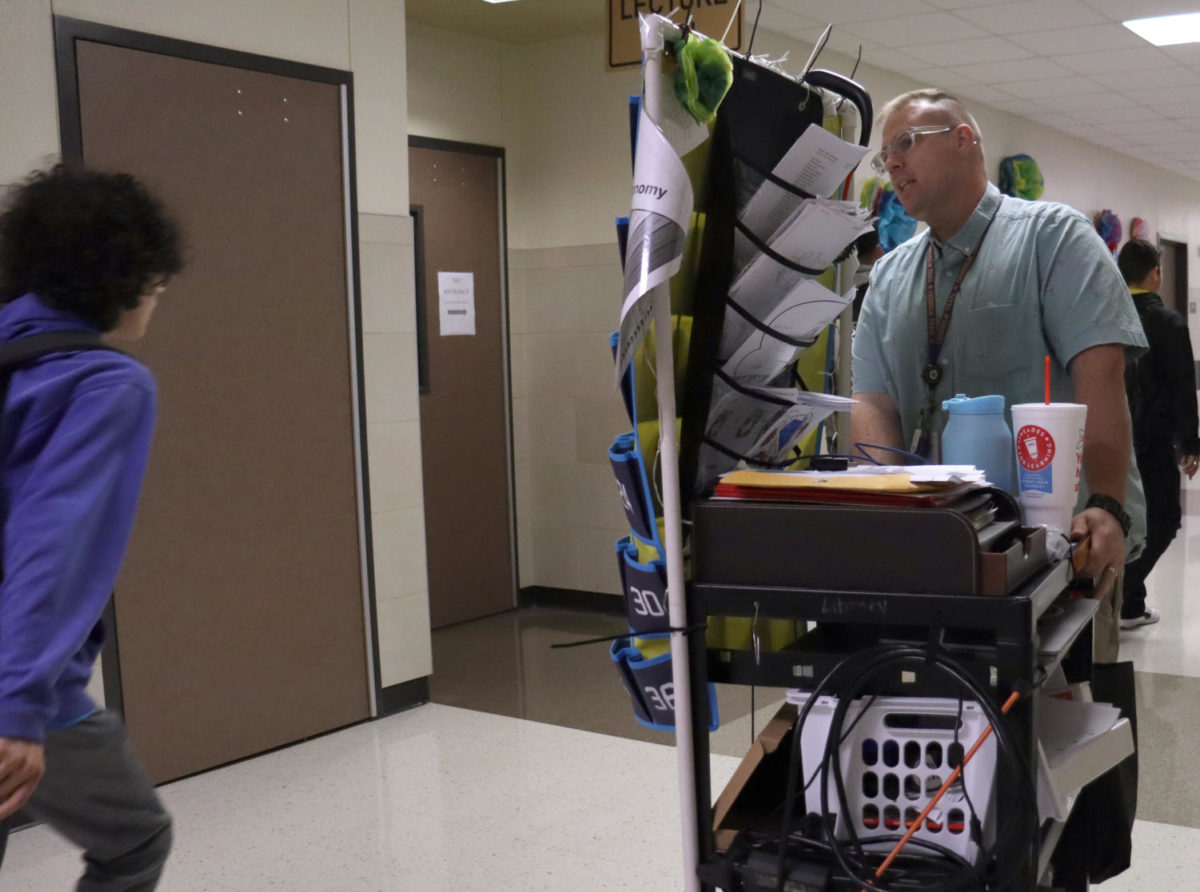Teachers, students discuss how shortage affect classrooms, learning
As he heads to his fifth period classroom, Spanish teacher Johnathan Hicks moves his cart down the 300 hallway during the passing period since he does not have a classroom to himself. Photo by Daylin Mitchell-Cochran, 12
November 2, 2022
Schools have been struggling to find and hire teachers due to the teacher shortage happening across America, and that struggle is felt on campus as well.
“It’s hard to fill teaching positions,” substitute coordinator Carrie Kitzmann said. “They’re scared because of things they’ve heard in the news and things they’ve seen on television and not knowing how they would be affected. It’s the fear of the unknown.”
According to the Texas Tribune, more than half of Texas’s public school districts don’t require teachers to be certified, and English teacher Reagan Teinert is one of the teachers on campus who is working towards alternative certification.
“Their first choice would not be an alternate certification,” Teinert said. “But there is such a shortage now that they’re going to hold me to a very high standard, and I have to meet that standard if I want to stay here.”
Teachers who teach without certification are not as well prepared compared to teachers with certification, and alternative certification programs allow teaching hopefuls the opportunity to learn what’s necessary to teach in a classroom setting.
“Any gaps in my education, I know will affect their education,” Teinert said. “I’m learning a lot more on the fly rather than having a formal background. Anything I know I’m lacking; I make sure I reach out to teachers who are experienced.”
Long-term substitutes can be a choice for vacant teacher spots, but Kitzmann said is not the greatest choice.
“They’re basically babysitting in the classroom,” Kitzmann said. “Our teachers are worn out. They have to cover other people’s classes, it’s very difficult. Therefore, the students aren’t getting taught the material they need to be taught.”
Teacher Sarah Zamzow said she has young kids, and the last-minute emergencies are the hardest time to find a sub because she knows “those are days they are not going to be able to find anyone.”
“Teachers they are being pulled from their planning period, so they are trying to do their own lesson planning,” Zamzow said. “That can be really difficult to also manage a classroom when you should be having a break.”
During the 2020-21 school year the number of teachers leaving was nine percent. This school year the percentage has gone up to 12%.
“The shortage has been affecting me for many years,” long-term substitute Ryan Bunkley said. “It’s difficult [because] there’s not enough teachers, not enough subs, I miss my conference period, miss lunch sometimes covering other classes.”
Teacher salary can often be a significant factor in a teacher’s decision to leave or stay, and Kitzmann said these factors are something to consider when looking for applicants.
“Not only is it because of the pandemic and because of the violence in the schools, salary makes a difference as well,” Kitzmann said. “If pay was more, more teachers would stay. Younger people are wanting more salary than what teachers make.”
This year is Zamzow’s second year teaching, and she se said for her getting a job was easy because “everyone wanted to hire.”
“Coming in and looking for work there were a lot more opportunities,” Zamzow said. “Everyone was very welcoming and excited to have new teachers everyone’s encouraging and supportive so that on a positive side has been great.”
While there are open positions, student populations are on the rise, and CTHS now faces not having enough rooms to fill with students and teachers, so school’s are employing teachers without their own classes, so they can move from class to class to teach students.
“It creates unique challenges,” Spanish teacher Johnathan Hicks said. “I try to limit things like paper, so it cuts down on how much I have to take from class to class. It’s hard to not have your own space for storage. In the past, I had posters and things to refer back to as we progress through lessons. I don’t really have that opportunity now.”




